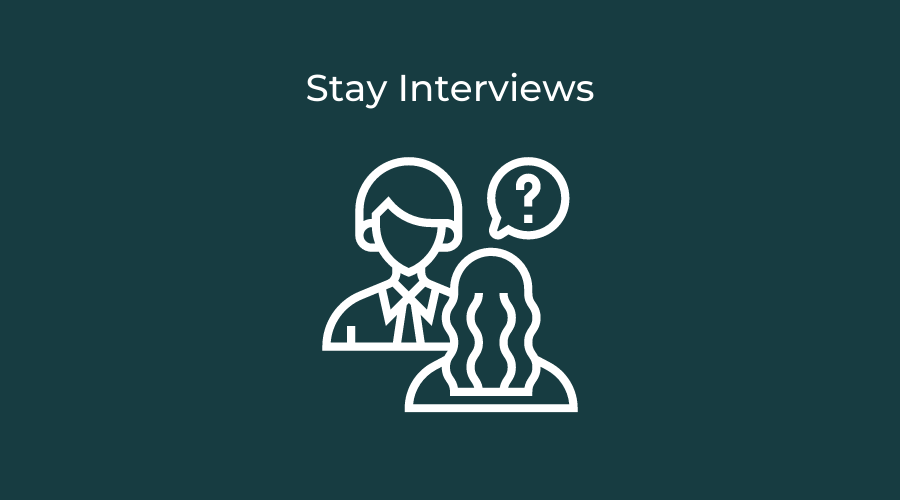
Stay Interviews 101
Employees are increasingly looking to work for companies who go above and beyond to keep them engaged. Employee engagement levels may be one of the best indicators of employee satisfaction and future retention. There are multiple avenues employers can take to get employees talking about their professional desires and level of current happiness with the employer. One way to gauge employee satisfaction is to conduct stay interviews.
What is a Stay Interview?
A stay interview is an honest two-sided conversation an employer has with an employee with the goal to encourage and gain feedback from the employee in order to keep them retained. Stay interviews have gained traction and popularity over the last couple of years as the job market tightens and the ‘great resignation’ continues. Recruiters are aggressively reaching out to passive candidates. For employers who want to make sure their employees know why they want to be at their current job, stay interviews may be a great tool.
To be clear, a stay interview is not the conversation that is had while an employee has one foot out the door. It is not the talk management has with an employee to negotiate them not leaving. It is pre-emptive to that. It is a preventative step with hopes to avoid that possibility.
Who Should Use Stay Interviews?
The stay interview process is not an optimal strategy for every company. Organizations with trust issues, failing culture, or workplace toxicity will not want to open up two- way conversations for employees to give feedback. They would need to focus on primary objectives initially. Stay interviews are perfect for companies with well established trust, open door management, and stable retention. Open communication must already be an established value in order for the stay interview to be successful.
Being Prepared for Stay Interviews
Before conducting the stay interview, it would be helpful to complete a needs analysis to determine goals in mind. The goals will be a necessary benchmark for an evaluation following the stay interviews to understand whether they were effective or not. It is always important to have a process in place prior to implementing a new engagement or retention strategy, otherwise there would be no way of knowing whether it made any difference or not. Employers must have a plan in place to evaluate responses that need action.
Companies preparing for stay interview must be ready for the challenges that may come with asking employees for transparency. Management must be willing to hear about difficult and complex issues that may arise. Unpleasant realities may come to the surface that are unexpected. Managers may have to accept accountability for situations that employees are dissatisfied with. The interviewer conducting the stay interviews must be mature, possessing advanced relational and communication skills. They must be an active listener, ready and eager to make employees feel heard.
How to Conduct a Stay Interview?
Prior to beginning, the structure of the interview should be determined. Decide who will be involved in the process. How will interviews be announced? Providing advance notice and preparation advice will allow employees to provide honest feedback without being caught off guard. Although stay interviews should be conducted in an informal conversational manner, the questions should be predetermined and structured. Interviewers should be well trained on how to conduct the interview properly. Conduct all the interviews within a few weeks of each other to obtain the most up to date response. The interview should be no longer than 30 minutes. For employees who seem nervous, interviewers should work hard to be vulnerable and help put the conversation at ease. Be sure to thank employees for their time and willingness to share openly. Offer them an opportunity to follow up should there be anything else they feel needs to be shared in the future.
What questions to ask?
Below are example questions that can be asked during the interview. Always begin the conversation with an opener that promotes casual open communication such as:
“Thank you for taking the time to speak with us. This is an informal open conversation. I’d like to gain more understanding about how you feel your job is going so that I can support you and help this be a great place to work.”
“What makes you look forward to coming to work?”
“In what ways do you currently feel professionally challenged?”
“How comfortable are you with your current workload?”
“What do you like most and least about coming to work here?”
“How do you feel about the impact of your work?”
“If you could change anything about working here, what would it be?”
“Do you feel recognized and appreciated for your contributions?”
“What do you see yourself doing with our company over the next 5 years?”
“In what areas could you learn more?”
“What can management do more or less of to create increased satisfaction for you?”
“Over the last year, what has caused anxiety or frustration for you here?”
“What would be your dream job here?”
Stephanie Mauney is freelance writer and content curator specializing in Human Resources.

.png?width=352&name=empl-experience%20(1).png)
